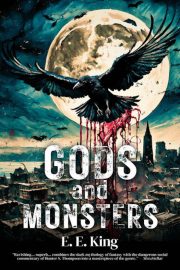Guest Post: Beyond the First Two Pages
by Nancy Fulda
 “Hook your reader in the first paragraph,” the advice goes. And it’s good advice.
“Hook your reader in the first paragraph,” the advice goes. And it’s good advice.
The logistics of slush piles demand ruthlessness, and stories that don’t intrigue the reader early on won’t get a second chance later. So, you’ve got your hook. It’s dramatic, it’s ingenious, and it’s free of typos. Your first two pages have been polished to near oblivion. Now what?
Now you must face an agonizing truth.
Getting the slusher to read your story is not the same thing as getting your story out of the slush pile. For that, my friends, you need more than a stage hook and a shiny first page. You need a functioning story.
When I was an editorial associate at Baen’s Universe, I noticed three factors that drastically increased a story’s chances of being passed on for review. They are: the right hook, a focused mid-story, and a wrap-up with resonance. We’ll discuss each in turn.
The Right Hook:
The worst thing you can do is hook a slush reader’s attention and then irritate her. I often feel irritated at manuscripts that don’t use the proper hook for the story.
Suppose your story starts with the sentence, “She was ninety years old, and had only died five times.” That’s a pretty good hook. But suppose the story then fails to explain how one can die five times and still live to be ninety years old. In fact, suppose the story isn’t about the ninety-year-old woman at all, but is really about her nephew, and the old lady only shows up for two sentences in the opening scene. That’s an improper hook. It’s not relevant, it’s not foreshadowing events to come, and it’s piquing my interest about issues that are never explored during the story. In other words, it’s a surefire way to make me throw down the manuscript in disgust.
A second way to irritate your slush reader—and I know some people advocate this approach, and some people actually pull it off, but trust me, it’s a tough sell—is the hook-to-flashback. In this approach, the story opens with a dramatic and complicated situation. After about two paragraphs of well-written and intriguing material, the story dives into a three-page flashback that chronicles exactly how the opening state of events came to be. This generally only works in literary stories which focus on character developments and the complex chain of events that can lead a character from emotional point A to emotional point B. If you’re writing an action/adventure shoot-em-up thriller, forget it. Once I know that Sheriff Do-Gooder ends up locked in the cellar with molten lava pouring through the windows, I’m not particularly interested in reading three pages about how he got there. I’m far more curious about how he’s going to get out.
Remember, no matter how good your hook is, the rest of the story must build on it and get more interesting as events progress. A spectacular hook can become a handicap if you aren’t able to follow up on it. If your hook is the most exciting part of your story, take two steps back and reevaluate. It’s supposed to be the hook, not the climax.
A Focused Mid-Story:
Some stories open well, but then meander their way to oblivion a few pages in. Characters live, die, or go about their daily lives, doing things that usually happen in daily life, but that leave the slush reader wondering where it’s all going. Let’s say Phillip woke up with a bulls-eye symbol tattooed on his chest. He’s confused about it. Then he goes to work, makes a few phone calls, tries to ask the cute secretary out to dinner… and at this point I’m wondering, “What’s it all about? Why are we worrying about the emails and the date? What have they got to do with anything?”
The problem, you see, is that the mid-story has no focus. The author has hooked the reader’s interest with the bulls-eye (and let’s suppose it really is the right hook for the story, and will play a central role in the plot). But there’s nothing connecting the various bits of the story together, no framework that lets the reader understand why the author selected these particular segments of Phillip’s life for discussion rather than showing us (for example) Phillip’s breakfast cereal or the traffic accident he passed on the way to work.
Suppose we add a bit of focus to the story. Phillip is concerned about the bulls-eye. He suspects it’s a hoax by a co-worker. So he rushes to work and sifts through his email looking for clues about who might be angry enough to pull such a prank. The cute secretary at the front desk is always full of workplace gossip, so he decides to ask her out and see if she lets something slip over dinner.
Or, if you don’t like using the mystery of the bulls-eye as the story’s focus, how about this approach: Phillip sees the bulls-eye and realizes there’s no way he’ll be able to hide the results of his latest drunken revel from his embittered wife. He rushes to work and tries to look busy answering his emails, but really he’s just thinking, “This is it. It’s over. She’ll leave me for sure.” He then decides that if he’s going to lose his wife anyway, there’s nothing to stop him from making a pass at the secretary at the front desk today.
The central focus of a story might be a mystery, a theme, a conflict. It may be blatant or subtle, but it must be present.
A Wrap-Up with Resonance:
In my opinion, the conclusion of a story is the hardest part to get right. You have to tie up loose ends, bring the action to a close, and cast a glimpse into the future, all in a way that satisfies the reader. In addition, a truly great story must leave an echo of itself in the reader’s mind.
What do I mean by that? I mean that some piece of the story stays with the reader long after the pages have been laid aside. This could be anything from the horror story that keeps you up until 3 a.m. to the lighthearted fantasy that you find yourself quoting to your friends. A powerful story leaves the reader altered, for good or ill. It touches his emotions. It fills him with new ideas. It has resonance.
Unfortunately, there is no handy formula for creating resonance. It’s an intricate combination of reader empathy and authorial genius, and different stories will resonate with different readers. I can tell you what resonance is not. It is not a moral or a political agenda. It is not witty repartee, a sudden twist ending, or a violation of social mores. Any or all of these may be present in a story with resonance, but they do not create the resonance.
In my opinion, the best way to create a story with resonance is to write a story that resonates with you, the author, as you are writing it. A story written from the heart, with passion and feeling, may be lacking in matters of craft and technique, but it has resonated with at least one person, and chances are good that it will resonate with others. Learn craft and technique, by all means. They are essential tools for creating publishable stories. But do not allow the quest for technical perfection to quench the inner fire that inspired the story to begin with. Who wants to write immaculate, soulless stories?
So. The right hook, a focused mid-story, and a wrap-up with resonance. Without exception, those three factors were present in every story I recommended for further consideration at Baen’s Universe. Now go home. Look at your manuscripts-in-progress, and ask yourself whether they meet these criteria. If they do, fantastic! If they don’t, consider revising them. Your local slush reader will thank you.
Nancy Fulda is a Phobos Award Winner, a Vera Hinckley Mayhew Award recipient, and this year’s Jim Baen Memorial Award winner. Her fiction has appeared in Asimov’s Science Fiction magazine, Jim Baen’s Universe, and Baen.com. This post first appeared on her blog.


